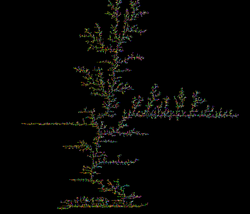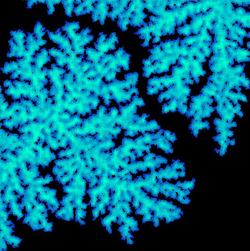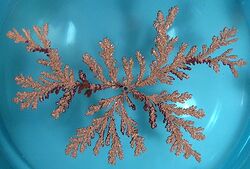Brownian tree

A Brownian tree, whose name is derived from Robert Brown via Brownian motion, is a form of computer art that was briefly popular in the 1990s, when home computers started to have sufficient power to simulate Brownian motion. Brownian trees are mathematical models of dendritic structures associated with the physical process known as diffusion-limited aggregation.
A Brownian tree is built with these steps: first, a "seed" is placed somewhere on the screen. Then, a particle is placed in a random position of the screen, and moved randomly until it bumps against the seed. The particle is left there, and another particle is placed in a random position and moved until it bumps against the seed or any previous particle, and so on.



The resulting tree can have many different shapes, depending on principally three factors:
- the seed position
- the initial particle position (anywhere on the screen, from a circle surrounding the seed, from the top of the screen, etc.)
- the moving algorithm (usually random, but for example a particle can be deleted if it goes too far from the seed, etc.)
Particle color can change between iterations, giving interesting effects.
At the time of their popularity (helped by a Scientific American article in the Computer Recreations section, December 1988), a common computer took hours, and even days, to generate a small tree. Today's computers can generate trees with tens of thousands of particles in minutes or seconds.
These trees can also be grown easily in an electrodeposition cell, and are the direct result of diffusion-limited aggregation.

This article does not cite any external source. HandWiki requires at least one external source. See citing external sources. (2021) (Learn how and when to remove this template message) |




